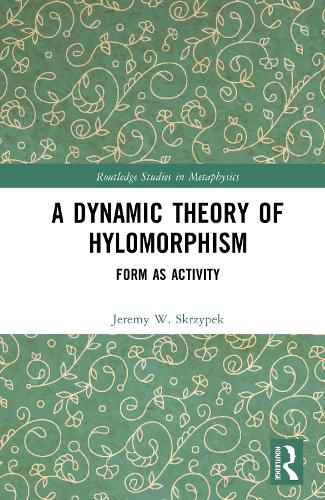Readings Newsletter
Become a Readings Member to make your shopping experience even easier.
Sign in or sign up for free!
You’re not far away from qualifying for FREE standard shipping within Australia
You’ve qualified for FREE standard shipping within Australia
The cart is loading…






This book introduces a novel hylomorphic theory of material objects, according to which material objects are understood as comprised or composed of both matter and activity, where activity plays the role of form. This theory, "hyloenergeism", better captures the dynamic nature of many of the objects of our experience, such as living organisms, than other leading varieties of contemporary hylomorphism.
Hylomorphism is the theory according to which material objects are understood as comprised or composed of two fundamental parts, components, aspects, or principles: matter and form. Many contemporary hylomorphists endorse a version according to which the form of a material object is understood as a certain kind of complex relation or structure realized in its material parts. Others endorse a version according to which the form of a material object is understood as a certain kind of power or disposition continuously activated in the object or in its material parts. This book argues against structural and dispositional varieties of hylomorphism in favor of a third approach: hyloenergeism. Drawing on various aspects of traditional Aristotelian hylomorphism and other contemporary occurrence-based theories of material objects, it argues that hyloenergeism has the resources to successfully avoid or resolve several major concerns for other competing hylomorphic views.
A Dynamic Theory of Hylomorphism will appeal to researchers and graduate students working in metaphysics, ancient philosophy, and medieval philosophy.
$9.00 standard shipping within Australia
FREE standard shipping within Australia for orders over $100.00
Express & International shipping calculated at checkout
This book introduces a novel hylomorphic theory of material objects, according to which material objects are understood as comprised or composed of both matter and activity, where activity plays the role of form. This theory, "hyloenergeism", better captures the dynamic nature of many of the objects of our experience, such as living organisms, than other leading varieties of contemporary hylomorphism.
Hylomorphism is the theory according to which material objects are understood as comprised or composed of two fundamental parts, components, aspects, or principles: matter and form. Many contemporary hylomorphists endorse a version according to which the form of a material object is understood as a certain kind of complex relation or structure realized in its material parts. Others endorse a version according to which the form of a material object is understood as a certain kind of power or disposition continuously activated in the object or in its material parts. This book argues against structural and dispositional varieties of hylomorphism in favor of a third approach: hyloenergeism. Drawing on various aspects of traditional Aristotelian hylomorphism and other contemporary occurrence-based theories of material objects, it argues that hyloenergeism has the resources to successfully avoid or resolve several major concerns for other competing hylomorphic views.
A Dynamic Theory of Hylomorphism will appeal to researchers and graduate students working in metaphysics, ancient philosophy, and medieval philosophy.